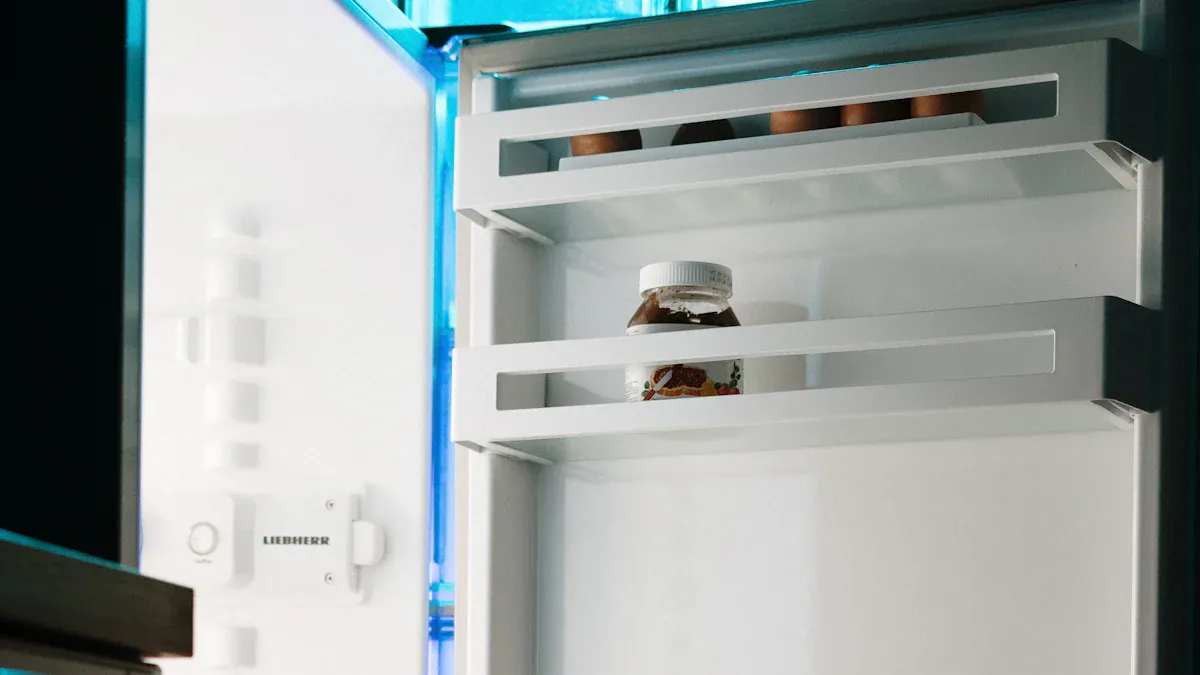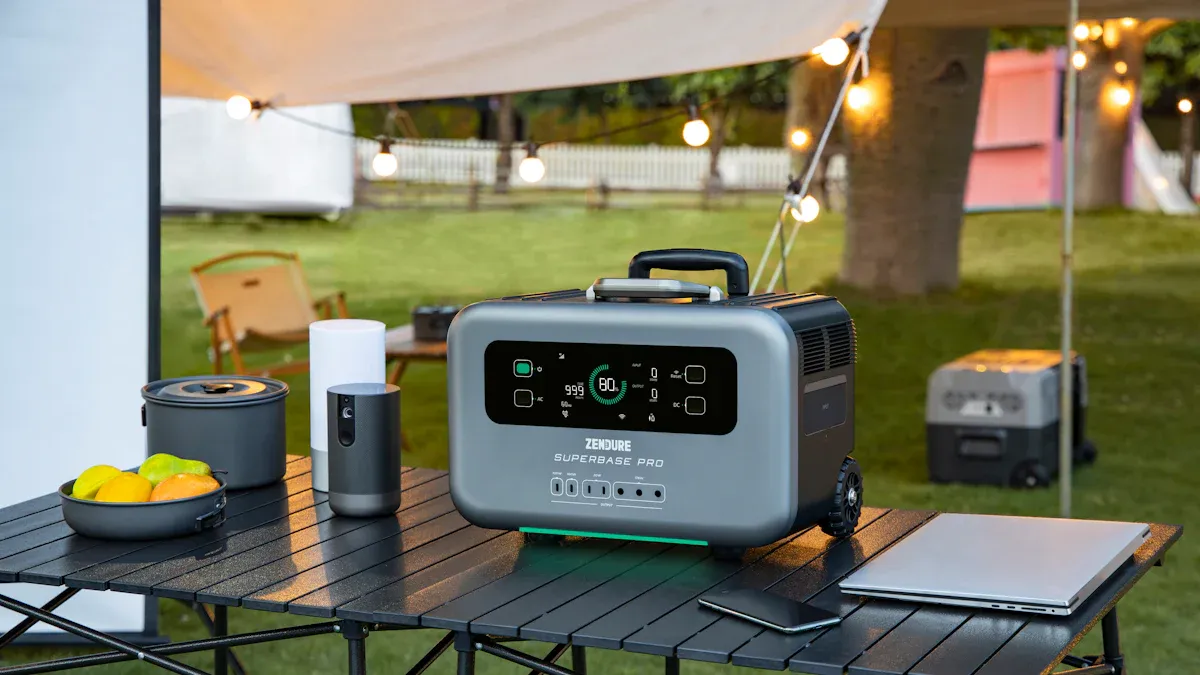
Proper maintenance ensures a portable fridge for car use operates efficiently and lasts longer. Most portable fridge freezers can last up to 20 years, provided they are well-maintained. Regular cleaning, such as removing dust from coils, enhances performance and durability. Mini portable coolers also support modern travel by preserving food hygiene and freshness. The growing demand for portability car cooler solutions highlights their importance in outdoor adventures. Furthermore, cooler refrigerated units remain essential for energy efficiency, making them indispensable for travelers.
Adopting good practices, like cleaning coils, helps freezers function smoothly and maintain their lifespan.
Clean Your Portable Fridge for Car Regularly

Remove and Wash All Removable Parts
Cleaning the removable parts of a portable fridge for car use is essential for maintaining hygiene and functionality. Start by unplugging the fridge to ensure safety. Remove shelves, trays, and any detachable compartments. Wash these parts with warm water and a mild detergent. Use a soft sponge or cloth to avoid scratching the surfaces. Rinse thoroughly and let them air dry before reassembling. Regular cleaning of these components prevents the buildup of food residue and bacteria, ensuring a fresh and odor-free interior.
Use Mild Cleaning Solutions for the Interior
The interior of a portable fridge for car use requires gentle care to avoid damage. Opt for a mild cleaning solution, such as a mixture of water and baking soda or a diluted vinegar solution. Apply the solution using a soft cloth or sponge, wiping down all surfaces, including corners and crevices. Avoid using harsh chemicals or abrasive materials, as they can harm the fridge’s lining. After cleaning, wipe the interior with a damp cloth to remove any residue, then dry it completely to prevent moisture buildup.
Tip: Regularly cleaning the interior not only maintains hygiene but also helps preserve the freshness of stored items.
Defrost the Fridge to Prevent Ice Buildup
Ice buildup can reduce the efficiency of a portable fridge for car use. To defrost, unplug the fridge and remove all items. Leave the door open to allow the ice to melt naturally. Place a towel or tray underneath to catch the water. For faster defrosting, use a bowl of warm water inside the fridge to speed up the process. Once the ice has melted, clean and dry the interior thoroughly. Regular defrosting ensures optimal cooling performance and extends the lifespan of the appliance.
Clean the Exterior and Cooling Components
The exterior of a portable fridge for car use also requires attention. Wipe down the outer surface with a damp cloth and a mild cleaning solution to remove dirt and stains. Pay special attention to the cooling components, such as vents and coils, as dust accumulation can hinder performance. Use a soft brush or vacuum cleaner to clear dust from these areas. Keeping the exterior and cooling components clean ensures efficient operation and prevents overheating.
Use Your Portable Fridge for Car Properly
Avoid Overloading to Maintain Airflow
Overloading a portable fridge for car use can obstruct airflow, reducing its cooling efficiency. To ensure optimal performance:
- Regularly check for debris blocking the air vents.
- Inspect fan blades for dirt buildup and confirm they are undamaged.
- Observe evaporator coils for frost accumulation and perform defrost cycles as needed.
Proper airflow allows the cooling system to function efficiently, preventing unnecessary strain on the compressor. This practice not only extends the lifespan of the fridge but also ensures consistent cooling for your stored items.
Tip: Leave some space between items inside the fridge to allow air to circulate freely.
Pre-Chill Items Before Storing
Pre-chilling items before placing them in a portable fridge for car use reduces the workload on its cooling system. This simple step offers several benefits:
- It helps maintain a stable internal temperature during travel.
- Energy consumption decreases, leading to cost savings.
- Battery life improves when using portable power sources.
By pre-cooling both the fridge and its contents, users can enhance the appliance’s efficiency and ensure their food and beverages stay fresh for longer.
Maintain Proper Ventilation Around the Fridge
Proper ventilation is critical for the efficient operation of a portable fridge for car use. The cooling system absorbs heat from inside the fridge and releases it externally. Without adequate ventilation, this process becomes inefficient, leading to increased energy consumption. To prevent this:
- Ensure the fridge is placed in a well-ventilated area.
- Avoid placing it against walls or other objects that block airflow.
- Keep the cooling vents clean and free from obstructions.
Note: Reduced overheating minimizes strain on the compressor, which lowers power consumption and extends the fridge’s lifespan.
Set the Optimal Temperature Range (3°C to 5°C)
Setting the correct temperature is essential for preserving food and beverages. The ideal range for a portable fridge for car use is between 3°C and 5°C (37°F to 41°F). This range significantly slows bacterial growth, reducing food spoilage and ensuring safety. Maintaining this temperature not only protects perishable items but also optimizes the fridge’s energy efficiency.
Pro Tip: Use a thermometer to monitor the internal temperature and adjust settings as needed to stay within the recommended range.
Store Your Portable Fridge for Car Correctly

Empty and Clean the Fridge Before Long-Term Storage
Preparing a portable fridge for long-term storage begins with emptying its contents. Remove all food and beverages to prevent spoilage and odors. Clean the interior thoroughly using a mild cleaning solution and a soft cloth. Pay attention to corners and crevices where residue may accumulate. Dry the fridge completely to avoid moisture buildup, which can lead to mold or mildew. Proper cleaning ensures the fridge remains hygienic and ready for use when needed.
Tip: Leave the door slightly ajar during storage to promote airflow and prevent unpleasant odors.
Store in a Dry, Cool Place Away from Direct Sunlight
The storage environment plays a crucial role in preserving the condition of a portable fridge. Choose a location that is dry and cool to prevent damage caused by humidity or extreme temperatures. Avoid areas exposed to direct sunlight, as UV rays can degrade the fridge’s exterior and affect its cooling components. A stable environment minimizes wear and tear, ensuring the fridge remains functional for years.
Use an Insulated Cover for Added Protection
An insulated cover provides multiple benefits for a portable fridge during storage:
- Protects against scratches and physical damage, maintaining the fridge’s appearance.
- Shields the fridge from dust, dirt, and moisture, preserving its functionality.
- Acts as a barrier against UV rays and rain, enhancing its longevity.
- Helps maintain a stable internal temperature, reducing strain on the cooling system and improving energy efficiency.
Using an insulated cover ensures the fridge stays in optimal condition, ready for its next adventure.
Protect the Fridge from Dust and Moisture
Dust and moisture can harm the cooling components and exterior of a portable fridge. Cover the fridge with a protective layer, such as a cloth or plastic sheet, to keep it clean. Ensure the storage area is free from leaks or dampness to prevent corrosion. Regularly inspect the fridge during storage to address any issues promptly. These precautions safeguard the appliance from environmental damage, extending its lifespan.
Troubleshoot Common Issues with Your Portable Fridge for Car
Check Power Supply and Connections
Power supply issues are among the most common problems users face with portable car fridges. Begin by inspecting the power cord and plug for visible damage. Ensure the fridge is securely connected to the power source, whether it’s a 12V or 24V vehicle outlet. Compatibility problems between these outlets affect 34% of users, as shown in the table below.
| Issue Description | Percentage of Users Affected |
|---|---|
| Compatibility problems between 12V and 24V vehicle outlets | 34% |
| Underperformance in compressor units due to inconsistent voltage supply | 29% |
| Insufficient cooling in single-zone models in high-temperature zones | 31% |
| Impact of lack of standardized plug systems on international travelers | 26% |

If the fridge still doesn’t work, check the battery voltage. Low voltage can cause the compressor to underperform, leading to insufficient cooling.
Inspect and Clear Blockages in Air Vents
Blocked air vents reduce cooling efficiency and strain the compressor. Regularly inspect the vents for dust or debris. Use a soft brush or vacuum cleaner to clear blockages. Ensure the fridge has adequate space around it for proper ventilation. Poor ventilation can also cause overheating, which impacts performance.
Address Unusual Noises or Temperature Fluctuations
Unusual noises often indicate compressor issues or loose components. Inspect the compressor for signs of damage or overheating. Temperature fluctuations may result from insufficient refrigerant or environmental factors. Look for oil stains, which could signal a refrigerant leak, and avoid placing the fridge in direct sunlight.
Monitor Battery Management to Avoid Power Issues
Effective battery management ensures reliable operation. Devices like the Emvolio portable refrigerator demonstrate how advanced battery systems maintain performance. Tested under extreme conditions, it operates for up to 10 hours at 2–8°C, even in 43°C ambient temperatures. This highlights the importance of using a fridge with robust battery management to avoid power interruptions.
Regular maintenance ensures a portable fridge for car use remains efficient and durable. Cleaning, proper usage, and careful storage prevent common issues and extend its lifespan. Troubleshooting minor problems early avoids costly repairs. These practices guarantee optimal performance, energy efficiency, and reliability, making the fridge a dependable companion for every journey.
FAQ
How often should you clean your portable car fridge?
Clean the fridge every two weeks or after extended use. Regular cleaning prevents bacteria buildup and ensures optimal cooling performance.
Can you use any cleaning solution for the fridge interior?
Use mild solutions like diluted vinegar or baking soda. Avoid harsh chemicals to protect the fridge’s lining and maintain its durability.
What is the best way to store the fridge during winter?
Store the fridge in a dry, cool place. Use an insulated cover for protection and leave the door slightly ajar to prevent odors.
Post time: Jun-09-2025

